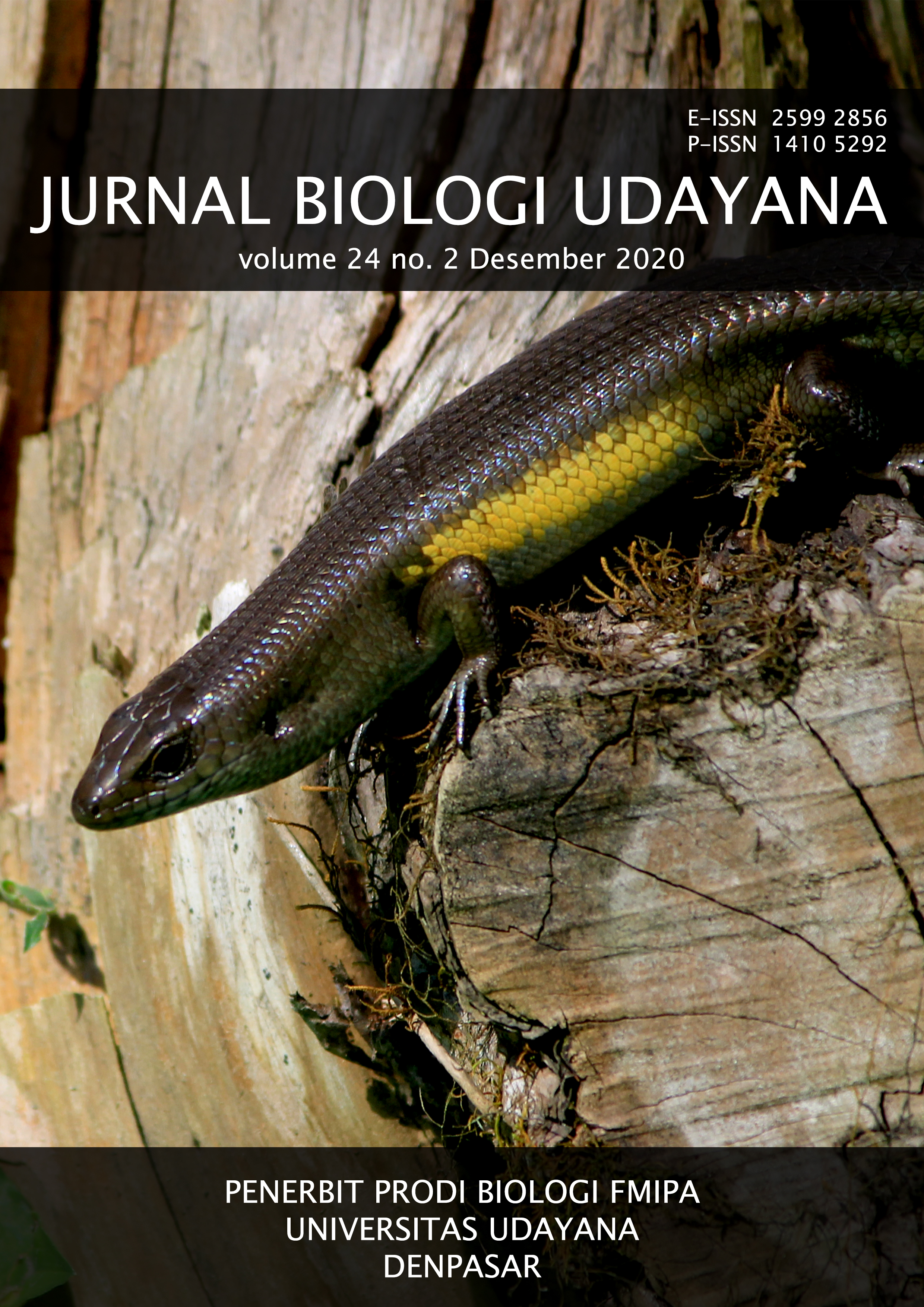Checklist of gastropoda from Lombok Island and its satellite islands
Abstract
Lombok, an island that lies in the Lesser Sunda Islands, is popular for the tourist destination. One attempt to promote tourism is through the biodiversity of its fauna. This study aims are to summarized the diversity of gastropoda and made a checklist to make it easier studied. Museum collections and fifteen works of literature were used as the data source. A total of 74 families and 292 species of gastropoda were documented from 29 locations. Twenty-one species are new records for Lombok Island. About 29% of them have their representation in the museum collections. The list dominated by marine (65%), following by terrestrial (15%), mangrove (6%), and freshwater species (5%). The most diverse family, Neritidae, which occupies wider habitat is represented by nine percent. Littoraria scabra is the most widely distributed species which occurs in 12 locations. The five most diverse locations were marine habitats which popular for tourism destinations. This study contributes to the development of marine ecotourism.
Downloads
References
Ascui SH, Seow M. (Editors). 2005. DK Eyewitness Travel Guides Bali And Lombok. Dorling Kindersley Limited: London.
Athifah, Putri MN, Wahyudi SI, Edy R, Rohyani IS. 2019. Keanekaragaman Mollusca sebagai bioindikator kualitas perairan di kawasan TPA Kebon Kongok Lombok Barat. Jurnal Biologi Tropis 19(1): 54-60.
Bashar MA. 2018. Vision on biodiversity: ecotourism and biodiversity conservation in Bangladesh. Journal of Biodiversity Conservation and Bioresource Management 4(1): 1-10.
Benthem Jutting WSSV. 1955. Susswassermollusken von Sumba. Verhandlungen der Naturforschenden Gesellschaft in Basel ¬66: 49-69.
Bouchet P, Rocroi JP. 2005. Classification and nomenclátor of gastropod families. Malacologia, 47(1-2): 1-397.
Candri DA, Junaedah B, Ahyadi H, Zamroni Y. 2018. Keanekaragaman moluska pada ekosistem mangrove di Pulau Lombok. BioWallacea Jurnal Ilmiah Ilmu Biologi 4(2): 88-93.
Candri DA, Sani LH, Ahyadi H, Farista B. 2020. Struktur komunitas Moluska di kawasan mangrove alami dan rehabilitasi pesisir selatan Pulau Lombok. Jurnal Biologi Tropis 20(1): 139-147.
Hylleberg J. 1999. Molluscs from beaches on Bali, Lombok, Sumbawa, and Komodo Islands, Indonesia. Phuket Marine Biological Center Special Publication 19(2): 397-402.
Isnaningsih NR. 2015. Komunitas moluska di ekosistem mangrove Pulau Lombok. Oseanologi dan Limnologi di Indonesia 41(2): 121-131.
Kastoro W, Saito H, Hasegawa K. 2000. Phylum Mollusca. In : Matsura K, Sumadhiharga OK, Tsukamoto K. (eds). Field Guide to Lombok Island: Identification Guide to Marine Organisms in Seagrass Beds of Lombok Island, Indonesia. Ocean Research Institute: Tokyo.
Kitchener DJ, Boeadi, Charlton L, Maharadatunkamsi. 1990. The wild Mammals of Lombok Island: Nusa Tenggara, Indonesia: systematics and natural history. Records of the Western Australian Museum Supplement No. 33: 1-129.
Kuncoro A, Sudaryono A, Sujangka A, Setyabudi H, Suminto. 2013. Pengaruh pemberian pakan buatan dengan sumber protein yang berbeda terhadap efisiensi pakan, laju pertumbuhan, dan kelulushidupan benih abalone hybrid. Journal of Aquaculture Management and Technology 2(3): 56-63.
Monk KA, Fretes YD, Lilley GR. 2000. Ekologi Nusa Tenggara dan Maluku. Seri Ekologi Indonesia. Buku V. Prenhallindo: Jakarta.
Mudjiono, Sudjoko B. 1994. Fauna moluska padang lamun dari pantai Pulau Lombok Selatan. In: Kiswara W, Moosa MK, Hutomo M (eds) Struktur Komunitas Biologi Padang Lamun di Pantai Selatan Lombok dan Kondisi Lingkungannya. Puslitbang Oseanografi LIPI: Jakarta.
Mudjiono. 1997. Telaah struktur komunitas moluska di rataan terumbu Gili Trawangan, Gili Meno, dan Gili Air, Lombok Barat (NTB). Prosiding Seminar Nasional Pengelolaan Terumbu Karang: 96-103.
Mujiono N. 2016. Gastropoda mangrove dari Pulau Lombok, Nusa Tenggara Barat. Oseanologi dan Limnologi di Indonesia 1(3): 39-50.
Parorrongan JR, Zahida F, Yuda IP. 2018. Keanekaragaman dan kelimpahan Gastropoda di Pantai Seger, Lombok Tengah. Biota 3(2): 79-86.
Páll-Gergely B, Otani JU, Hosoda T, Asami T, Harl J. 2018. A new species of Camaenidae (Gastropoda, Pulmonata) from Nusa Penida and Lombok Islands, Indonesia: novelty in a well-known fauna. Molluscan Research 38(1): 41-49.
Prahoro P, Sisco AP. 2000. Keanekaragaman jenis keong (Gastropoda) di Pantai Ujung Kelor, Batunampar, dan Gunung Linus Teluk Ekas, Lombok Timur (NTB). Jurnal Penelitian Perikanan lndonesia 6(2): 84-91.
Poutiers J. 1998. Gastropods. In: Carpenter KE & Niem VH (eds). FAO Species Identification Guide for Fishery Purpose. The Living Marine Resources of the Western Central Pacific. Volume 1. Seaweeds, Corals, Bivalves, and Gastropods. FAO: Rome.
Rensch B. 1931. Die molluskenfauna der Kleinen Sunda-Inseln Bali, Lombok, Sumbawa, Flores und Sumba. I. Zoologische Jahrbücher Abteilung für Systematik, Ökologie und Geographie der Tiere 61: 361-396.
Rensch B. 1932. Die molluskenfauna der Kleinen Sunda-Inseln Bali, Lombok, Sumbawa, Flores und Sumba. II. Zoologische Jahrbücher Abteilung für Systematik, Ökologie und Geographie der Tiere 63: 1-130.
Rensch, B. 1934. Die molluskenfauna der Kleinen Sunda-Inseln Bali, Lombok, Sumbawa, Flores und Sumba. III. Zoologische Jahrbücher Abteilung für Systematik, Ökologie und Geographie der Tiere 65: 389-422.
Rosenberg G. 2014. A new critical estimate of named species-level diversity of the recent Mollusca. American Malacological Bulletin 32(2): 308-322.
Rustiami H, Windadri FI, Tihurua EF, Sunarti S, Sulistyaningsih LD, Dewi, Rugayah, Rahayu M, Mansur M, Mahyuni R. 2020. Checklist Flora of Lombok. Herbarium Bogoriense, Research Center for Biology, Indonesian Institute of Sciences: Bogor.
Santhanam R. 2017. Biology and Ecology of Venomous Marine Snails. Apple Academic Press: New Jersey.
Sinaga DS, Melki, Setyono DED. 2015. Studi pertumbuhan abalon tropis (Haliotis asinina) dengan pemberian pakan buatan yang berbeda. Maspari Journal 7(1): 21-28.
Smith EA. 1898. A list of the land-shells of the island of Lombock, with descriptions of new species. Proceedings of the Malacological Society of London 3: 26-33.
Strong EE, Gargominy O, Ponder WF, Bouchet P. 2008. Global diversity of gastropods (Gastropoda; Mollusca) in freshwater. Hydrobiologia 595:149-166.
Vermeullen JJ, Whitten AJ. 1998. Fauna Malesiana Guide to the Land Snail of Bali. Backhuys Publishers: Leiden.
Yusron E. 2010. Penelitian Kajian Diversitas Biota Laut di Perairan Lombok dan Sekitarnya, Nusa Tenggara Barat. Laporan Akhir Program Insentif Riset Peneliti Dan Perekayasa LIPI Tahun 2010. Puslit Oseanografi LIPI: Jakarta.
Zusron M, Wibowo CA, Langgeng A, Firdausi FM, Etfanti S. 2015. Biodiversity of Mollusks at Ela-Ela Beach, Sekotong Lombok Barat Indonesia. KnE Life Sciences 2: 574-578.
http://www.molluscabase.org
http://www.marinespecies.org





